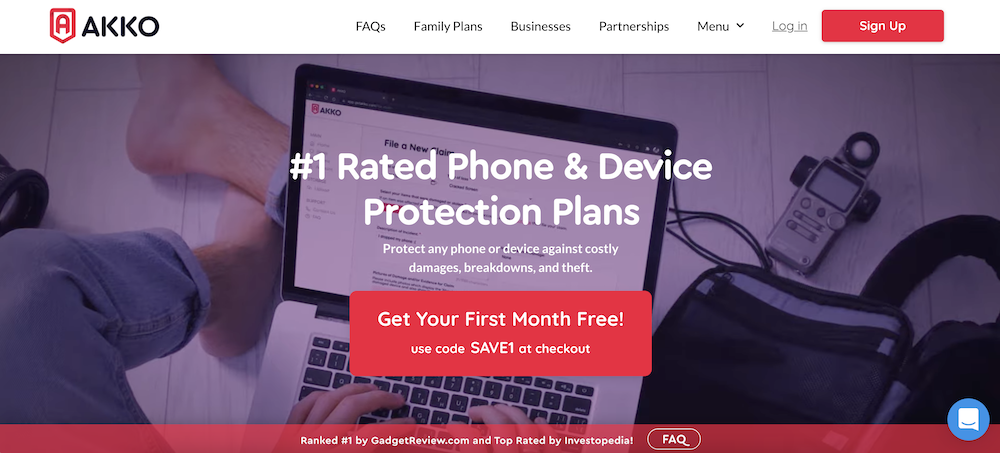Boosting Conversion Rate for AKKO: Social Ad Strategy + Creative + Web Design
The ability to combine strong social ad strategy with high quality ad creative and landing page optimization has been one of my biggest strategic wins of 2021 as a Growth Marketer at Tuff.
Turns out, it’s also one of the best ways to drive the strongest traffic to a page to convert an action.
The reason the results are so strong has to do with control. When we can control what the traffic views in our ads, how they enter and the experience they have when they get to the landing page, we’re able to control all aspects of the customer journey and build a seamless funnel to conversion.
Take for example our partner, AKKO (pronounced kinda like ‘Taco’ but ‘Aco’) a consumer fintech startup that came to us with great PPC traction for their phone and gadget insurance protection plans.
Knowing that they needed to convert more people than those just searching for products related to their brand with queries like
- phone insurance
- laptop insurance
In essence, they needed to diversify their ad strategy to scale.
Developing data-driven ad creative and a strong social foundation
To start, we put our resources into getting the right combination of performance creative for AKKO.
Before we launched ads, we spent 4 weeks putting together a collection of animated and UGC videos between 15 and 30 seconds long that we could test across Facebook, Instagram, and YouTube.
In hindsight, it would have been a massive misstep for us to use generic cracked phones and waterlogged computer stock images to begin our testing.
AKKO’s original social ad testing had gone this route and results had been mixed.
While we developed creative, our social ads and youtube channel experts put together an audience testing plan that detailed who and how we would test our new creatives across a potential audience of 290 Million smartphone users in the United States.
Launch Ads First Then Optimize
Now that our foundations were set, we launched ads first and directed them to an existing high-performing PPC landing page. This allowed us too figure out what ads of our had the most promise.
We could have launched with generic stock images and spent time working on a social ads landing page but that would have cost us time in the long run though.
While this approach to setting up a foundation, then launching, then optimizing was a longer process, it made it far easier for us to adapt with optimizations faster.
Early Results
The biggest difference between a targeted PPC strategy and a social ads strategy comes down to intent.
With PPC Campaigns, we’re able to get in front of people who already have a problem and are looking for a solution.
Generally, with social ads, we’re able to get in front of people who might have a problem and usually don’t know they have a problem. Essentially, we have to create intent in the social ad – give them a reason to realize they have a problem and need a solution.
The major differences in intent here dictate the landing page experience.
After a couple of weeks of limited conversions sending ad traffic from social ads to the PPC landing page, we found that the traffic did this on the website:
| ToS (Time on Site) | Pgs / Session | Purchases | CVR | |
| PPC LP | 0:00:30 | 2.31 | 5 | 0.30% |
In addition, we also used a website session recording tool to watch what the traffic was doing when they got to the website.
Their scrolling actions and clicks showed a lack of intent. Our ads may have pushed them to the website, but once they landed on the destination URL there wasn’t much to draw their attention.
For users coming off of PPC campaigns – in the act of searching for a solution to their problem – this type of landing page experience provided information to push them along.
Social Ads Landing Page
To counteract low onsite metrics that users exhibited once they got to the landing page, we went back to the drawing board to develop a landing page specifically for our social campaigns that would use strong creative and copy to draw the user in and make the transition from the ad to the website much easier.
This would be the test to see if it was our ads or overall strategy to develop intent for users within social channels.
We leaned on FinTech inspiration from neobanks to guide our design concepts. The reason for this was simple – banking is boring. No one is thinking about finding their next bank when they’re scrolling feeds or binge-watching cat videos on Youtube.
Here’s a peek at the page we developed:
Second Round Of Results
While not immediate, we saw a quick change in behavior by users once they got to our social ads specific landing page. After a couple of weeks of testing, here are our social ads landing page compared to our PPC landing page.
| Before vs. After | Last Click Purchases | ToS (Time on Site) | Pages/Session | CVR |
| PPC Landing Page | 5 | 0:00:30 | 2.31 | 0.30% |
| Social Ads Landing Page | 20 | 0:01:47 | 4.19 | 3.86% |
We saw a 256% increase in our time on site average when users entered this landing page, but the biggest difference was in CVR and purchases.
Not only were users more engaged when the website through the destination URL from our ads, their likelihood to convert increased 1,186%.
Next Steps
While not anywhere close to done, these results provided us with the traction to scale spend on our prospecting and retargeting campaigns. It also enabled us to test new channels.
From a testing standpoint our next steps involved:
- New iterations of our social ads landing page
- New Ad Creative
- New Ad Copy
For more information on how Tuff tests, optimizes, and scales brands with Growth Marketing across industries click here to download a sample growth marketing proposal.







